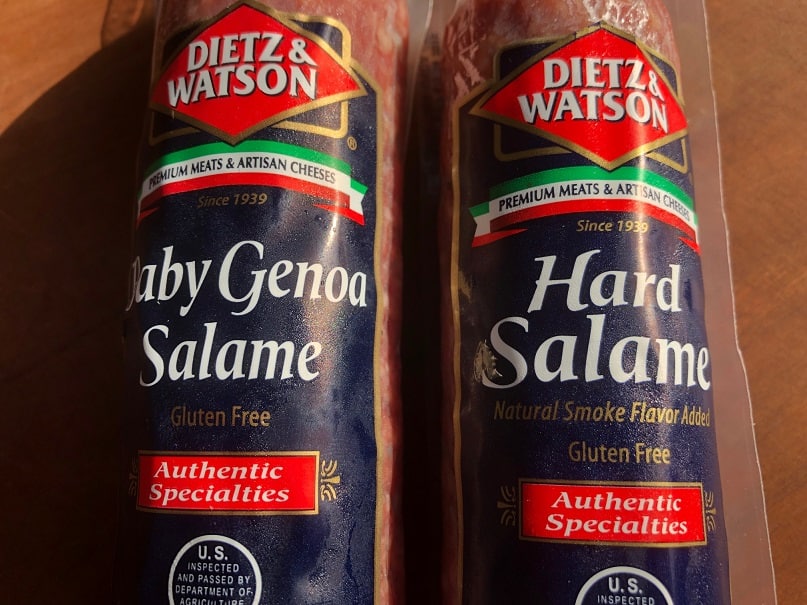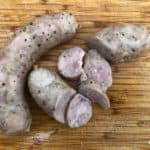If you have ever stood in front of a deli counter and wondered what was the difference between Genoa salami and Hard salami then you are not alone. These are two of the most common salamis in the United States and, while they are both delicious, what they actually are remains a mystery to most people.
Don’t worry though…telling these two sausages apart is pretty easy and while there are three primary differences there is really only one that matters.

The Three Differences Between Genoa and Hard Salami
I spent some time digging through my sausage textbooks and they were all pretty consistent of the differences between these sausages. The three things that stand out are:
- Hard salami is often smoked or has added smoke flavoring. Genoa salami is never smoked.
- Genoa salami is usually formulated with a dry Italian red wine. Hard salami does not contain wine.
- Genoa salami contains whole, or coarsely cracked, black peppercorns. Hard salami contains finely ground pepper.
The only difference that is really meaningful is the presence of whole peppercorns in the Genoa salami. Some people love the crunchy texture and spicy flavor of the peppercorn pieces while some folks hate them pick them out before eating Genoa salami. If you are the type of person that doesn’t like large pieces of peppercorn then order the Hard salami instead.

Both of these sausages can be made from a mixture of pork and beef or just pure pork.
What Is Salami?
A salami is a special sausage that takes skill and special equipment to prepare. A true salami is made of seasoned meat that is stuffed into a casing and dry cured at low temperatures for months. The meat in a salami never gets cooked but is still perfectly safe to eat.
A salami, which contains meat that has never been cooked, is safe to eat because of the complex dry curing process. The heart of the dry cure process is a battle to prevent harmful bacteria that would make us sick from growing inside the meat. Let’s take a look at the steps required to make a great salami.
High Standards
While you can play around and be a little sloppy when you are making a fresh cooked sausage like bratwurst, the game changes completely once you step into the dry curing arena.
The sanitation of all of your equipment has to be perfect. You are going to take whole cuts of meat and grind them freshly yourself. You are going to use a digital scale and precisely measure the ingredients.
The basic intent is that you are going to go to extreme lengths to make sure that you do not introduce any harmful bacteria into the salami. If harmful bacteria is not present when you start making the sausage then it will not be there when the sausage is ready to eat.
Competing Bacteria
The second step to prevent harmful bacteria from growing in the sausage is to introduce overwhelming competition. Salami makers will add a starter culture of harmless bacteria, commercially known as “Bactoferm”, into the sausage. After the sausage is stuffed into casings it is held in a fermentation chamber at a temperature of around 80 degrees F at high humidity for a day in order to encourage the Bactoferm to grow and bloom throughout the meat.
The growth of the Bactoferm bacteria in the sausage is a fermentation process very similar to the process used to make beer, bread and cheese. The fermentation process has many benefits. The primary benefit is that the fermentation makes the meat acidic to such a degree that harmful bacteria have a hard time surviving. The growth of the good bacteria also makes it harder for any harmful bacteria to find a place to grow.
The fermented nature of salami is what gives these sausages a “twang” flavor.
Reduced Water Content
Bacteria requires water to live and the process of dry curing is all about removing this essential requirement from the meat.
The sausages are held in a curing chamber for several months until they have lost about 25-30% of their original weight through moisture loss. The curing chamber should have a temperature of around 50 degrees F and have a humidity of around 50%.
The temperature and humidity are critical to insure that the sausage dries slowly and evenly. If the temperature is too high and the humidity is too low then the outside of the sausage will quickly dry out and form a hard shell. This is called “case hardening” and it prevents the water from the inside of the sausage from escaping.
When the sausage has lost 25-30% of its weight there is still moisture inside the salami but most of it is unavailable to the bacteria as it is chemically bound to the salt which is present at 2.5-3% in the sausage.
Nitrites and Nitrates
These are the big guns that make sure harmful bacteria, specifically the ones that cause botulism, are not present.
Nitrites are fast acting chemical salts that kill harmful bacteria. Think of nitrates as time release capsules for nitrites.
When the salami is first being made the nitrites in the mix are going around and killing bacteria but they eventually get used up. As the sausage ages the nitrates slowly break down and release more nitrites to continue the bacteria killing mission.
Want To Make Your Own?
Let me talk you out of it.
Most people are not willing to do the sanitation required to safely make these sausages nor are they willing to invest in a fermentation chamber or dry curing chamber. It is better to leave these sausages to the professionals.
If you are serious though, here are the books that you have to read:
- The Art of Making Fermented Sausages, Marianski and Marianski
- Charcuterie, Ruhlman and Polycyn
- Great Sausage Recipes and Meat Curing, Kutas

